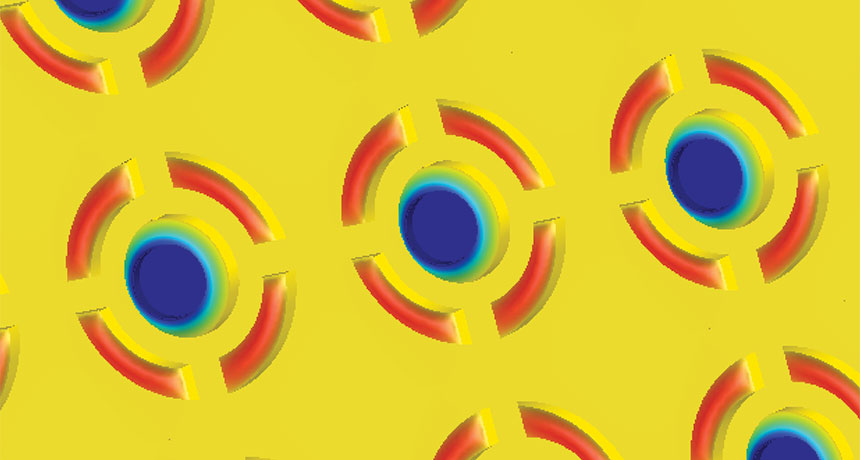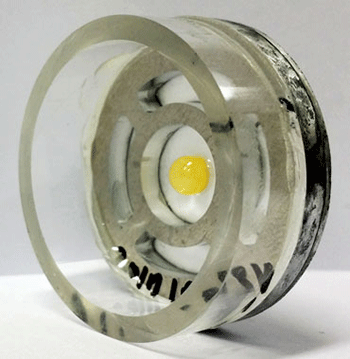New device makes water give up its sounds
With the use of this new device, underwater sounds are no longer kept from reaching the air

A new device helps underwater sound reach the air. This illustration shows how the device vibrates. Blue and red indicate vibrations in opposite directions.
SAM LEE/YONSEI UNIVERSITY
Share this:
- Share via email (Opens in new window) Email
- Click to share on Facebook (Opens in new window) Facebook
- Click to share on X (Opens in new window) X
- Click to share on Pinterest (Opens in new window) Pinterest
- Click to share on Reddit (Opens in new window) Reddit
- Share to Google Classroom (Opens in new window) Google Classroom
- Click to print (Opens in new window) Print
By Dan Garisto
Don’t expect to play a game of Marco Polo by shouting from under the pool’s surface. No one will hear you. Normally, a tiny fraction of one percent of a sound will move from water into the air. But a new type of device might one day greatly up that amount.
Researchers have created a device that frees underwater sound to move through the water’s surface and into the air. It lets 30 percent of the sound come through. That’s 160 times more than usual!
Playing Marco Polo isn’t the only thing for which this device could be used. A future version might help eavesdrop on noisy marine life or spy on submarines. The research was done by a team at Yonsei University in Seoul, South Korea. Eun Bok and his colleagues described their new technology in the January 26 issue of Physical Review Letters.

At the heart of the new device is a rubber sheet stretched across a metal frame with a weight at its center. That weight helps make sure that when it vibrates, it does so at the right frequency. This whole system floats atop the water. As underwater sound waves hit it, the device begins to vibrate. Its frame and rubber sheet vibrate at just the right frequency to help transmit that subsurface sound into the air.
Oliver Wright also worked on the study. He is an applied physicist at Hokkaido University in Sapporo, Japan. “A ‘hard’ surface like a table or water reflects almost 100 percent of sound,” he notes. In other words, it would send the underwater sound back away from the surface.
Both water and air resist the flow of sound. But because of its density, water resists sound some 3,600 times more than air does. Scientists have figured out how to transmit some sound waves from underwater. To do this, they place onto the surface of the water a thick layer of material that has no air bubbles. (Glass, metal or plastic would work.) Instead of blocking the soundwaves, this bubble-free material now helps those sounds pass through. But to cover a large area, this would be costly, and therefore not practical.
Bok’s team developed an alternative approach. Even though it is thin and lightweight, their membrane transmits sound as well as the thick layer of material.
“It’s a tour de force of experimental demonstration,” says Oleg Godin. This physicist, who was not involved in the new study, works at the Naval Postgraduate School in Monterey, Calif. Still, he says, “I’m less impressed by the suggestions and implications about its uses.” He describes them as mostly “wishful thinking.”
The device is not yet ready for prime time, its developers note. For instance, it doesn’t work on sound that arrives at the device from an angle. On the surface of a lake or ocean, therefore, it would transmit sounds only from the small area directly below it. The device also works for only a small range of sounds. Those with a higher or lower pitch would still reflect off the underside of it instead of passing through the water’s surface.
Bok’s team thinks it can overcome these problems and even link many of these devices together into a big sheet. We’ll be keeping an ear on their progress.






